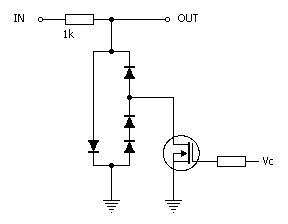

|

Producing Asymmetrical Clipping
One little used effects technique is the “warp control”. This control is used to change the harmonic content of the clipped output from primarily odd harmonics to a mixture of even and odd harmonics. This makes the sound smoother and less buzzy, and can even add a bit of octave-up character.
One could speculate that the reason this type of control is not often used in commercial boxes is that the change in sound is noticeable but subtle. It is not a drastic enough that the added cost, complexity and extra control knob space can be justified. There are a variety of simple ways to implement a warp control, and the sound character that they produce is not identical. The easiest way is a derivative of the “compliance control” in series with clipping diodes as shown above. The variable resistance in series with the clipping diodes acts as a volume control for the harmonics. At max resistance there is little clipping and therefore few of the odd harmonics that are generated by clipping the audio signal, and at zero resistance the circuit functions as a normal clipper with symmetrical clipping.
In this clipper each half of the signal swing is limited to about 0.7v peak by the shunting action of the diodes to ground. However, on the negative signal excursion, the variable resistance and the series input resistor are producing a voltage divider, which reduces the output level of that part of the signal. The positive voltage swing can go to 0.7 volt but the negative swing is limited to some lower level. This causes asymmetrical clipping of the input, which produces even harmonics in the output.
A variation of this basic warp control is shown below and it produces a slightly different effect. The wiper of the variable resistor can be adjusted to change the amount of resistance in series with both clipping diodes. When in the center position, both diodes have resistance in series, which reduces the level of the odd harmonics being produced. As the wiper is adjusted to either side, an imbalanced is produced in the clipping level being produced by the diodes and even harmonics are added to the mix. This setup has the disadvantage that there is always some resistance in series with one or both of the diodes. A value of 2k ohms would be a good starting point fot experimentation with this circuit. If an additional diode is added to the last shown warp control, an additional limit can be placed on the circuit action.
So far, the diode types have not been specified but it is assumed that they are identical silicon diodes in each circuit. Different diode junction materials have different forward voltage drops, which produce different peak clipping points in the output signal.
By mixing diode types, the clipping levels of each side of the signal can be different, but by adding the warp control, the versatility of the circuit will be improved. As shown in the previous example, there are two negative clipping diodes with the balance between them controlled by the pot. Without the pot, the Ge diode would always conduct first and the Si diode would not come into play. The balance control allows either diode to be used by moving the wiper to the relative side, and moving the wiper to some intermediate position will mix the clipping effects of both types. The Ge diode could be changed to an LED or Schottky for a different sound, and even the silicon diode connected to the pot could be substituted. There are numerous combinations that are musically useful. By moving the variable resistance to a different position, the response of the warp control is changed.
The warp control can also be voltage controlled as shown below. When the control voltage (Vc) is grounded, the mosfet will be off and all three of the right side diodes are in the circuit. If a positive voltage (>5v) is applied to Vc, the mosfet will conduct and effectively become a low value resistor. The bottom two diodes are then bypassed and the clipping level is much lower. Vc could even be the output of a square wave oscillator and the mosfet would switch at the frequency of the square wave causing the harmonics to rapidly change from predominately even to odd, This produces unusual overtones in the output that have some of the characteristics of ring modulation, but less extreme. While a warp control will bring only a subtle change to the sound of a fuzz box, the effect is much more pronounced than selecting special 4558 ICs or changing resistors in the output buffer. Try one of these circuits to add an extra dimension to your homebrew fuzz sound. Also check out the Fet Muff on the AMZ CD-ROM which uses a unique method of clipping that involves diodes with switches. The second and third gain stages each have one diode that can be used to clip the relative half-cycle of the waveform. This produces asymmetrical clipping and even harmonics which can be further enhanced by switching one of the diodes out of the circuit allowing one side of the signal to be soft squashed by the jfet limits. This technique has not be used in any other circuit to my knowledge. The Fet Muff is not a high gain, hard distortion device but still worth trying. |
AMZ-FX Home Page
Lab Notebook Main Page
Guitar Effects Blog
©2002 Jack Orman
All Rights Reserved

 If the configuration of the compliance control is changed so that the resistance is in series with only one of the clipping diodes, a simple warp control is formed.
If the configuration of the compliance control is changed so that the resistance is in series with only one of the clipping diodes, a simple warp control is formed.

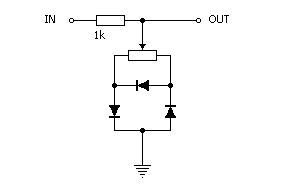 The diode that has been added as a shunt across the potentiometer has the added effect of placing a limit on the maximum imbalance that can be added with the warp control. Whenever the pot is set to the maximum travel to either side, the extra diode limits the signal level to 2 diode drops, or about 1.4 volts peak.
The diode that has been added as a shunt across the potentiometer has the added effect of placing a limit on the maximum imbalance that can be added with the warp control. Whenever the pot is set to the maximum travel to either side, the extra diode limits the signal level to 2 diode drops, or about 1.4 volts peak.
 Silicon diodes require approximately 0.7 volt higher bias on the anode than the cathode before they begin to conduct. Schottky diodes have lower forward voltage drops, as do germaniums while LEDs will be 1.6 volts or higher depending on the material required to produce the specific color.
Silicon diodes require approximately 0.7 volt higher bias on the anode than the cathode before they begin to conduct. Schottky diodes have lower forward voltage drops, as do germaniums while LEDs will be 1.6 volts or higher depending on the material required to produce the specific color.

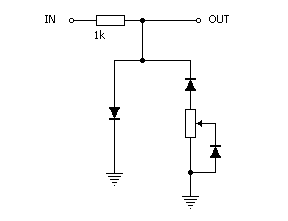 When I first drew the warp circuit to the left, I initially thought it would produce the same response as the previous design, but quickly realized it was slightly different. The previous circuit produces a symmetrical clipping effect when the wiper is all the way to the top but this circuit cannot achieve that condition.
When I first drew the warp circuit to the left, I initially thought it would produce the same response as the previous design, but quickly realized it was slightly different. The previous circuit produces a symmetrical clipping effect when the wiper is all the way to the top but this circuit cannot achieve that condition.
 By making the circuit slightly more complex, the clipping sound that is produced by different diode types can be put to use. The pot allows either clipping network to be used alone or blended in combination with the other.
By making the circuit slightly more complex, the clipping sound that is produced by different diode types can be put to use. The pot allows either clipping network to be used alone or blended in combination with the other.
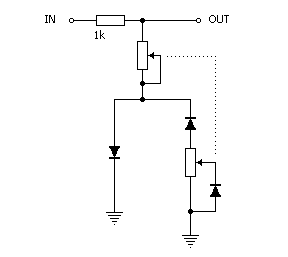 If a dual potentiometer is used to insert resistance at two points of he circuit simultaneously, the number of circuit variations increases substantially. A sample is shown in the next drawing.
If a dual potentiometer is used to insert resistance at two points of he circuit simultaneously, the number of circuit variations increases substantially. A sample is shown in the next drawing.
 If the signal driving the warp circuit is large enough, a network of diodes and a switch can be configured to allow different clip points (above right example). When used in conjunction with a variable resistance, the sound and the harmonics may be substantially modified. The diodes should be germanium or Schottky material since the forward voltage requirements of these diodes are lower and allow more precise control. When added to a simple fuzz like the Blue Clipper, MXR Distortion+ or DOD 280, this controls adds versatility and dimension to the sound.
If the signal driving the warp circuit is large enough, a network of diodes and a switch can be configured to allow different clip points (above right example). When used in conjunction with a variable resistance, the sound and the harmonics may be substantially modified. The diodes should be germanium or Schottky material since the forward voltage requirements of these diodes are lower and allow more precise control. When added to a simple fuzz like the Blue Clipper, MXR Distortion+ or DOD 280, this controls adds versatility and dimension to the sound.
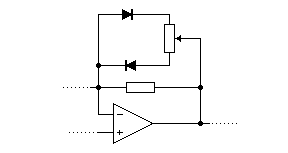 Some of the techniques outlined above can be adapted to distortion circuits that use op-amps with the diodes in the feedback loop. A simple way to adapt a warp control to a TS-9 type of circuit of shown here.
Some of the techniques outlined above can be adapted to distortion circuits that use op-amps with the diodes in the feedback loop. A simple way to adapt a warp control to a TS-9 type of circuit of shown here.
 An alternate version using the variable clipper technique from the AMZ cd-rom is shown to the left. It allows the clipping level through the Ge diode to be adjusted over a wide range.
An alternate version using the variable clipper technique from the AMZ cd-rom is shown to the left. It allows the clipping level through the Ge diode to be adjusted over a wide range.
 A control can be added to an op-amp circuit to change the conduction of the diodes and produce asymmetrical clipping. This is easily adapted to many typical fuzz circuits. Bypass the 36k resistor with a 10uF capacitor for more stable performance.
A control can be added to an op-amp circuit to change the conduction of the diodes and produce asymmetrical clipping. This is easily adapted to many typical fuzz circuits. Bypass the 36k resistor with a 10uF capacitor for more stable performance.
